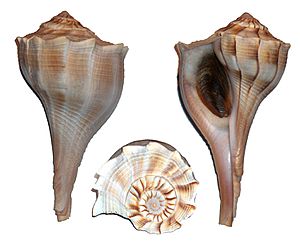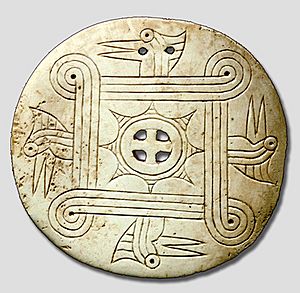Shell gorget facts for kids

Shell gorgets are special necklaces made by Native Americans. They are carved from polished shells and worn around the neck. These gorgets often have cool designs carved into them. Sometimes, colors are added, or small holes are made for decoration.
These shell necklaces were very popular among Native American groups in the Eastern Woodlands of the United States. They were common during the Hopewell tradition (around 200 BCE to 500 CE) and the Mississippian period (about 800 to 1500 CE). However, other tribes from different areas and times also made them. The oldest shell gorgets found are about 3,000 years old. People believe they showed a person's important position or rank. This could be for leaders, warriors, or religious figures. They might also have been worn as good luck charms. Some gorgets have holes that suggest they could have been spun to make whistling sounds, like a spinner.
Contents
How Shell Gorgets Were Made
The most common shell used for gorgets is the lightning whelk. Other shells, like the true conch (Strombus) and freshwater mussels, were also carved. Today, lightning whelks are much smaller than they used to be. The older shells were typically 6 to 12 inches long.
These shells were gathered from the coasts of Florida and the Gulf of Mexico. Then, they were traded across the Eastern Woodlands. This trading among Native American groups continued into the 1500s.
Gorgets were carved from a specific part of the shell. A piece was cut or broken out, then smoothed down. Holes were drilled for wearing the gorget and for decoration. Tools like bow drills or chert drills were used for this. The gorget usually had a curved shape. If it was engraved, the inside was polished and decorated.
Most gorgets are round. But some were made into rectangles with rounded corners, small masks, or other unique shapes. One very fancy necklace from Spiro Mounds looks like two hands joined by a beaded bracelet.
Early Shell Gorgets: Hopewell Period
The Adena culture made gorgets from slate and copper. But the Hopewell tradition brought special shells from the Gulf of Mexico to the north. At first, around 1000 BCE, Hopewell people carved plain shell gorgets. Engraved gorgets started appearing later in the Hopewell period. A shell gorget from the Glacial Kame culture in the Great Lakes area, also from 1000 BCE, has a carved bear or opossum on it.
Mississippian Shell Gorgets
Mississippian shell gorgets were traded far and wide. This means similar designs can be found in many different places. The Calusa people in southern Florida gathered and carved gorgets. Gorgets with coiled rattlesnakes were found among the Guale Indians of Georgia.
Mask gorgets are rare but have been found across the Southeast. Many are found in the Ohio River valley, eastern Tennessee, and the Arkansas delta. Some have even been found as far north as North Dakota. These masks have raised noses, drilled eyes, and carved or drilled mouths. They sometimes have special "forked-eye" designs or zigzags under the eyes. Small shell carvings, less than two inches wide, were found at Spiro Mounds. These mask gorgets likely came later, around 1500-1700 CE.
Meaning of the Designs
The pictures and symbols on shell gorgets come from the Mississippian Ideological Interaction Sphere. Very common designs include the triskele (a three-spiral shape), coiled rattlesnakes, spiders, chunkey players, and birdmen. The birdman is sometimes called a Falcon Impersonator.
Native Americans, art experts, and scientists have many different ideas about what these symbols mean. Gorgets with coiled rattlesnakes were often found in the graves of young people. This suggests they might relate to age rather than a person's status. The forked-eye design looks like markings on a peregrine falcon. This symbol goes back to the Hopewell period. Among the Muscogee Creek people, it means excellent vision and hunting skills. The "Strength of Life" design is seen by some as a whirlwind or dancing movement.
There are over 30 examples of the Cox Mound gorget style from before European contact. They were found in Tennessee and northern Alabama, dating from 1250 to 1450 CE. The Cox Mound gorget style shows four woodpecker heads facing counter-clockwise. It also has a four-looped square design, and sometimes a cross inside a rayed circle. This design might show a Yuchi myth about the winds.
The four-looped square is sometimes called a "whirling sun" or a special carrying chair for leaders. Others think it shows the earth held up by cords at the four main directions. It could also mean the path of life with four stages of growing up. Woodpeckers are linked to the four winds and are seen as healing birds by Muscogee Creeks. The rayed circle or sun can mean the sun itself, a god, ancestors, a council, or a sacred fire. The whole design might tell the Yuchi myth of the winds.
A gorget from the Castalian Springs Mound Site in Tennessee shows a man holding a club. Some experts think this might be a "flying shaman" (a spiritual healer).
There is some agreement on the meaning of the cross-in-circle design. It represents the sun and the ceremonial fire. This fire was fed by four logs placed towards the main directions. Another design that is widely understood is the water spider with a cross-in-circle on its body. Spider gorgets are found in many places, but especially in what is now Illinois.
Later Gorgets and Today

Sometimes, turtle shells and stones were also carved into gorgets. In the 1700s, metal medallions started to replace shell gorgets among Eastern tribes. In the late 1800s, women from tribes along the Colorado River, like the Quechan, wore gorgets made from clam shells. These were strung on plant cords.
Today, shell carving is slowly becoming popular again among Southeastern tribes. Knokovtee Scott (Cherokee Nation/Muscogee, 1951–2019) learned from tribal historians and medicine men. Scott carved gorgets using purple freshwater mussel shells from near Fort Sill, Oklahoma. Sandy Fife Wilson (Muscogee) from Oklahoma also carves shell gorgets and whelk shell cups. Antonio Grant (Eastern Band Cherokee) from North Carolina does too.
See also
- Long-nosed god maskette





